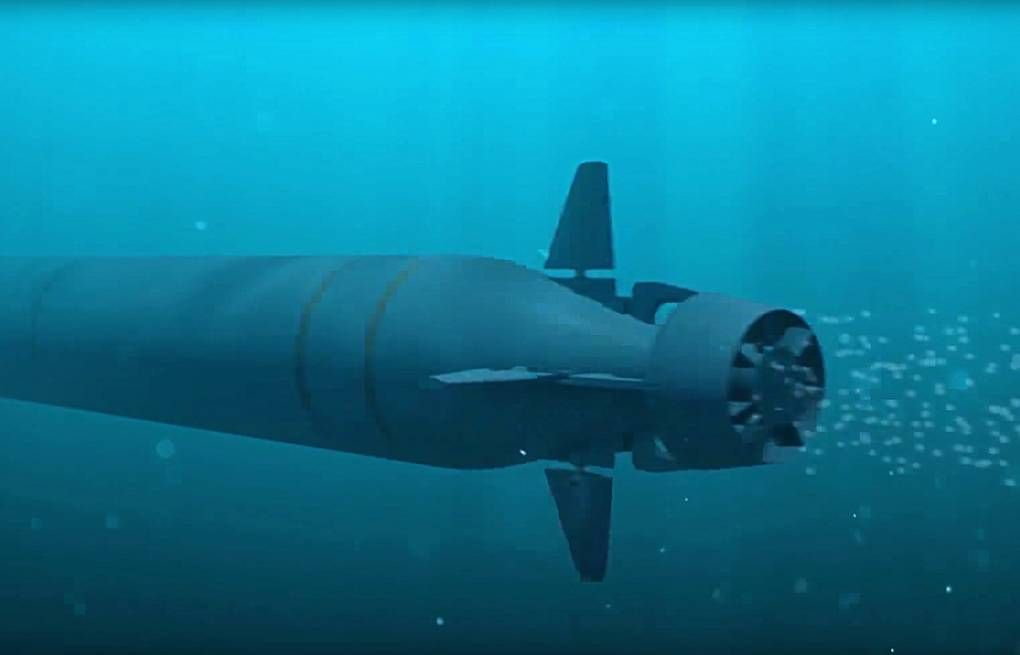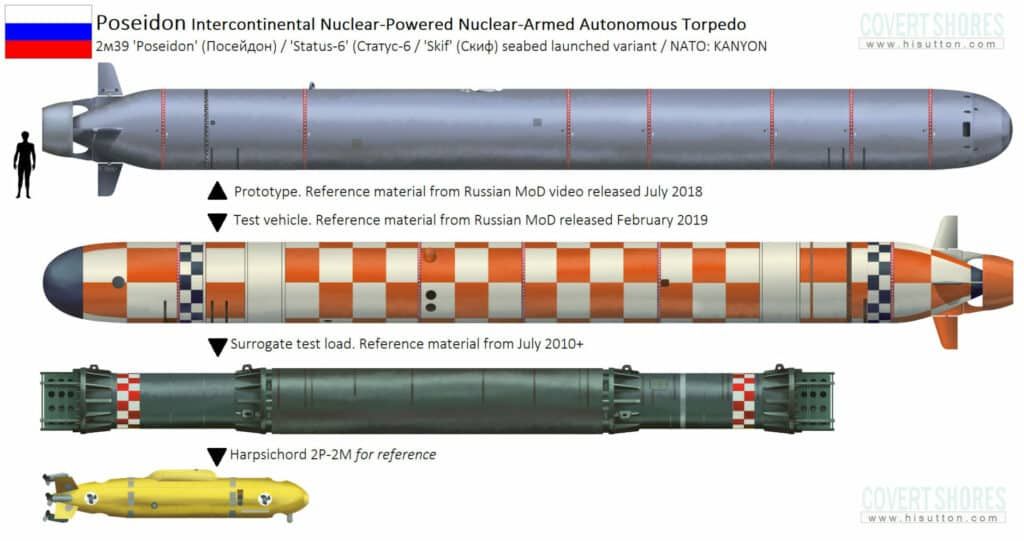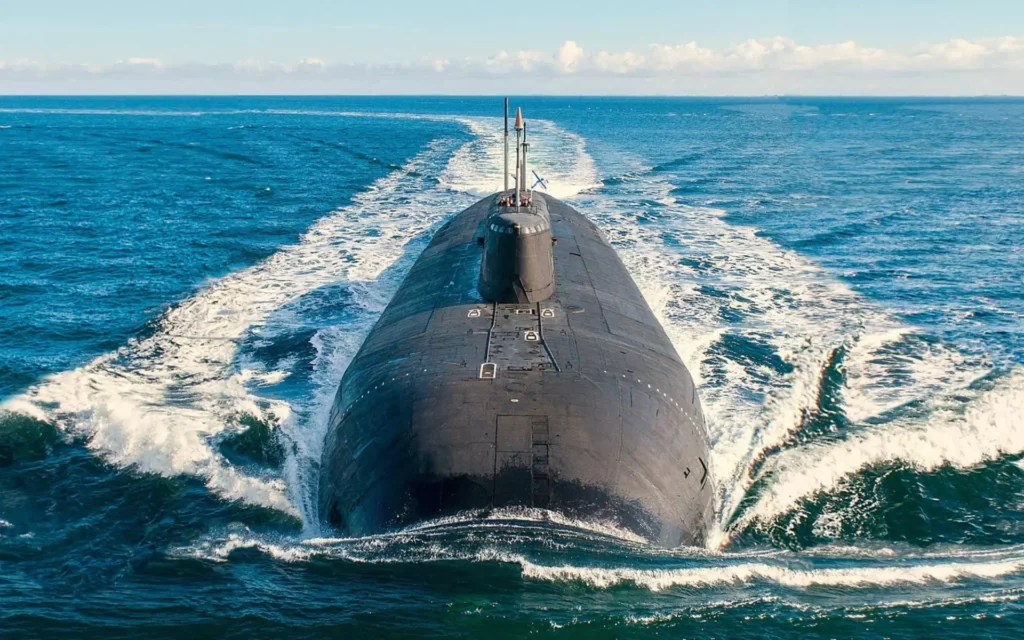One nuclear-armed Poseidon torpedo could decimate a coastal city. Russia wants 30 of them.
By Silky Kaur | June 14, 2023
 Computer-generated image of a "Poseidon" long-range nuclear-powered torpedo. (Image: Russian Defense Ministry)
Computer-generated image of a "Poseidon" long-range nuclear-powered torpedo. (Image: Russian Defense Ministry)
Imagine finding yourself on a serene seashore, only to realize that a catastrophic tsunami is imminent. However, this is no ordinary tsunami; this one is radioactive.
In January 2023, the Russian news agency TASS reported that Russia had produced the first set of nuclear-powered, very long range, nuclear-armed torpedoes known as “Poseidon.” Strategic experts are warning that the Poseidon torpedo would have the potential to devastate a coastal city, cause radioactive floods, and result in millions of deaths. Over the past few years, tabloid news outlets have painted a hauntingly vivid picture of a towering, 1,000-foot-tall radioactive tsunami violently crashing onto British shores, pulverizing everything in its path, and transforming whole cities into barren, lifeless lands.
Is Poseidon even real? In ancient Greek mythology, Poseidon was revered as the god of the oceans, protector of sailors and those who worked or traveled at sea. In the current context, “Poseidon” takes on a different meaning, with a destructive weapon capable of causing catastrophic events.
Russia’s Poseidon—also known in the United States as Kanyon, Ocean Multipurpose System, and Status-6—was first revealed by the Russian Navy in 2015 and reportedly tested for the first time in November 2016. The torpedo—a nuclear-powered underwater drone equipped with nuclear weapons—is designed to be launched from submarines. The first Poseidon is expected to be deployed by 2027.
There is buzz that this new weapon is poised to shake the landscape of modern warfare. And this may owe less to its borrowed name than to some unmatched features—at least on paper.
Powered by a compact nuclear reactor, it is believed the Poseidon could travel at unprecedented speeds of 100 knots (185 kilometers per hour), have a range of approximately 10,000 kilometers, and operate at depths of up to 1,000 meters. Designed to evade detection by acoustic tracking devices and other traps, the Poseidon has a diameter of approximately 1.6 to two meters. Particularly riveting is the torpedo’s devastating payload: a nuclear warhead with a likely yield of at least several megatons (with early reports suggesting it could yield up to 100 megatons). For comparison, Russia’s Tsar Bomba—the most powerful nuclear weapon ever tested—had an estimated blast yield of about 50 megatons.
While some reports claim that Russia’s Poseidon may exist only as a propaganda scheme, experts generally agree that the system is “very real” and has received significant resources from the Russian armed forces, although many details remain unknown. Intelligence reports have suggested that Poseidon has undergone many trials, evidenced by the fact that some submarines have been modified and some are being specially built to accommodate for the larger and heavier Poseidon. For instance, the Sarov submarine is believed to have been modified to test Poseidon prototypes. According to TASS, the Russian Navy intends to purchase at least 30 Poseidon torpedoes and deploy them on four submarines.

Poseidon’s origin and roles. The idea of torpedoes fitted with a nuclear warhead was first conceived in the 1950s, when the Soviet Union began two separate programs to develop submarine-launched nuclear torpedoes—the T-5 and the T-15. These programs were part of a broader strategy to expand the Soviet Union’s nuclear capabilities and gain an edge in a nuclear crisis.
In October 1962, during the Cuban Missile Crisis, a Soviet submarine armed with a T-5 nuclear- tipped torpedo came close to launching it against US forces because its commander, Valentin Savitsky, believed that a US-Soviet Union war had already started. It is only because the submarine’s deputy commander, Vasili Arkhipov, convinced other top officers that launching the torpedo would be a fatal mistake that a potential nuclear catastrophe was prevented.
The Poseidon torpedo, however, will have no human onboard to make critical decisions after it has been launched. It will be controlled through a combination of remote communications and onboard automation. These forms of guidance may lead to problems that include hacking by third parties, loss of control because of technical malfunctions, and environmentally caused accidents that may lead to wrong signaling and thus inadvertent escalation.
The Poseidon can be viewed as an evolution in Russia’s nuclear deterrence strategy. Russia currently possesses the Dead Hand, an automated nuclear weapons command system also known as the Perimeter. Established during the Cold War, the Perimeter was created to ensure that, in a crisis, the Soviet Union could respond to a nuclear first strike, even if Russia’s armed forces were destroyed and all its leadership was eliminated. But with the technological advances of US ballistic missile defense systems, the Russian Perimeter system, which concerns intercontinental ballistic missiles only, has lost its preeminence.
Russian authorities describe the Poseidon torpedo as a multi-purpose system, suggesting that it could serve several roles.
It is widely speculated that the Poseidon may have been developed as a reaction to advances in US ballistic missile defense capabilities. In March 2018, Russian President Putin stated that Poseidon and other advanced weapons were developed because of the demise of the 1972 US-Soviet Anti-Ballistic Missile Treaty, which Putin said was “the cornerstone of the international security system.” After the United States pulled out of the treaty in 2002 to build its new national missile defense system, Russia started working on improving their military equipment and weapons to maintain a strong nuclear deterrent capability against US assets.
Besides being touted as a weapon that can circumvent US ballistic missile defenses for use against aircraft carrier groups and coastal targets, Poseidon also reflects Russia’s larger nuclear strategy and doctrine. After the Cold War ended, the United States shifted its focus to de-emphasizing the role of nuclear weapons in its security strategy. But Russia continued to greatly rely on nuclear weapons and even adopted a nuclear doctrine of “escalate to de-escalate,” which consists of using nuclear coercion and messaging tactics to achieve strategic goals. The development and deployment of new nuclear weapons like the Poseidon are considered to contribute to Russia’s broader strategy.

Effect on strategic stability. Advances in artificial intelligence and the use of autonomous platforms for nuclear delivery such as unmanned aerial vehicles, unmanned underwater vehicles, and hypersonic glide vehicles have raised concerns over potential negative impacts on strategic stability. Weaker nuclear-armed countries would remain unable to keep up with progress in AI technologies, which also pose new risks by reducing the direct human control over nuclear weapons use. In this context, the deployment by Russia of its nuclear-capable, autonomous Poseidon torpedo could be seen to also threatening strategic stability.
However, many experts and US officials—including former US Defense Secretary James Mattis—believe that the addition of the Poseidon torpedo to Russia’s nuclear arsenal would not alter the existing strategic nuclear balance with the United States because Russia already possesses the capability to launch nuclear-armed missiles at US cities. The introduction of Poseidon would not significantly increase the existing threat and, even if used, its impact would be limited to coastal areas.
Instead, many see Poseidon primarily as a psychological weapon intended for nuclear signaling rather than for its actual use. Some even speculate that the Poseidon will remain at the prototype stage and serve mainly political objectives, such as renewed talks with the United States on ballistic missile defense systems. The weapon’s primary intent may be in the uncertainty, speculation, and fear it can provoke.
How to respond? Automated weapons like Poseidon, especially if controlled by artificial intelligence, undoubtedly add complexity to decision-making in a crisis. It effectively transforms AI into an active participant during times of strategic adversity. This has sparked a heated debate on whether these systems should be fully automated or not, as automation brings significant risks of misjudging the intentions of an opponent. To better understand the challenges posed by unmanned automated nuclear vehicles like Poseidon, further research is imperative, which requires gathering more information about the weapon itself.
While ensuring that research in automation only aims to reduce any risks associated with accidents or inadvertent use, it is equally important for countries to continue engaging in arms control and risk reduction talks whenever possible. Such dialogues may play a crucial role in providing insight into each other’s nuclear forces, helping to alleviate uncertainties about possible new weapon systems, including the Poseidon.
Together, we make the world safer.
The Bulletin elevates expert voices above the noise. But as an independent nonprofit organization, our operations depend on the support of readers like you. Help us continue to deliver quality journalism that holds leaders accountable. Your support of our work at any level is important. In return, we promise our coverage will be understandable, influential, vigilant, solution-oriented, and fair-minded. Together we can make a difference.
Keywords: Poseidon, Russian nuclear arsenal, autonomous weapons
Topics: Nuclear Weapons, Voices of Tomorrow















Russia couldn’t fight its way out of a wet paper sack. Using surplus tanks but building a super tech torpedo, makes perfect sense.
The torpedo does not exist. Russia has no working nuclear propulsion system for it and has never built a 100Mt weapon. Even the czar bomba was not a multistage weapon but a crude device constisting of eight 12,5 Mt weapons fused into one casing. The Poseidon is a psychological weapon.
You’re information is inaccurate. Zsar bombs was the first use of the “stroika” or “layer cake” style bomb…it was actually a 3 stage bomb, fission, fusion, fusion. The 3rd stage “tamper” of the original design was uranium and would have made it much closer to its 100mt design, but the scientists convinced the bosses to replace it with a lead tamper because the uranium version would have caused so many very dirty nuclear reactions, the fallout would have covered the world and may have been enough to be a world declaration of war. That change saved humanity from terrible radiation… Read more »
Great article. The Bulletin always has stories that go behind the usual news. I must admit this is a scary one if you don’t mind me saying. If they can build a Hydrogen bomb they will manage to get this done. Even one of these devices would lay waste to large portions of the U.S. Food belt with radioactive ash.There is no recovery from the use of large scale nuclear weapons. Will they build them? Let me quote what Carl Sagan said about our relationship with Russia. “Imagine a room awash in gasoline, and there are two implacable enemies in… Read more »
Japanese don’t even want to talk about Oppenheimer and do not want it shown in Japan. 2 small atomic bombs dropped on Hiroshima and Nagasaki are still affecting Japan.
Let me review. The US investing $10,000,000,000,000 in upgrades to ALL 3,800 of our nukes. We must have them ALL. Got nuclear subs, Have a “space Force”, Got Marines, Air Force, Navy, Army, Coast Guard, got F35, got Ospreys, got ALLIES all over Europe. Better get to spending, $842 billion for 2024, not including nuke upgrades. Give often. Give now.
this is dribble. Nothing travels 100 knots underwater, and even a 100 MT detonation won’t create the “1000 foot” tsunami the russians are on about. Even the massive tsunami that hit japan reached to about 40 foot at most and was the result of vastly higher amounts of energy